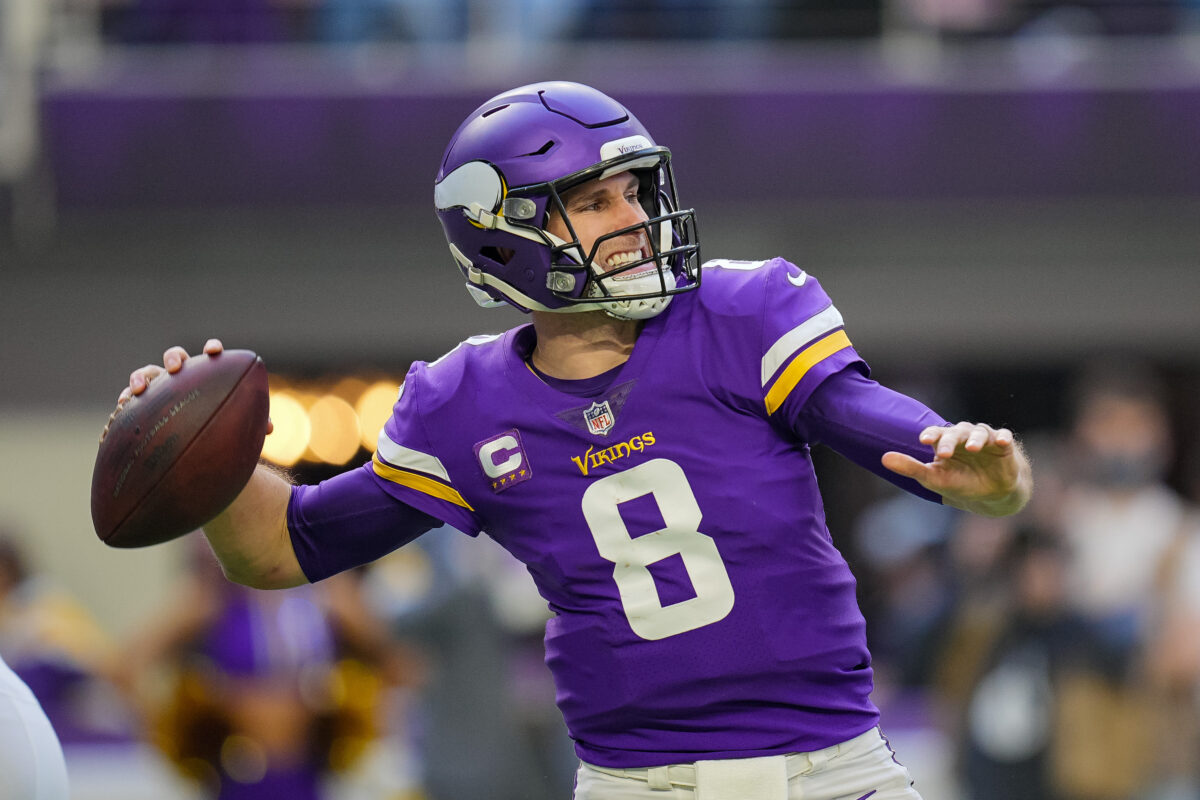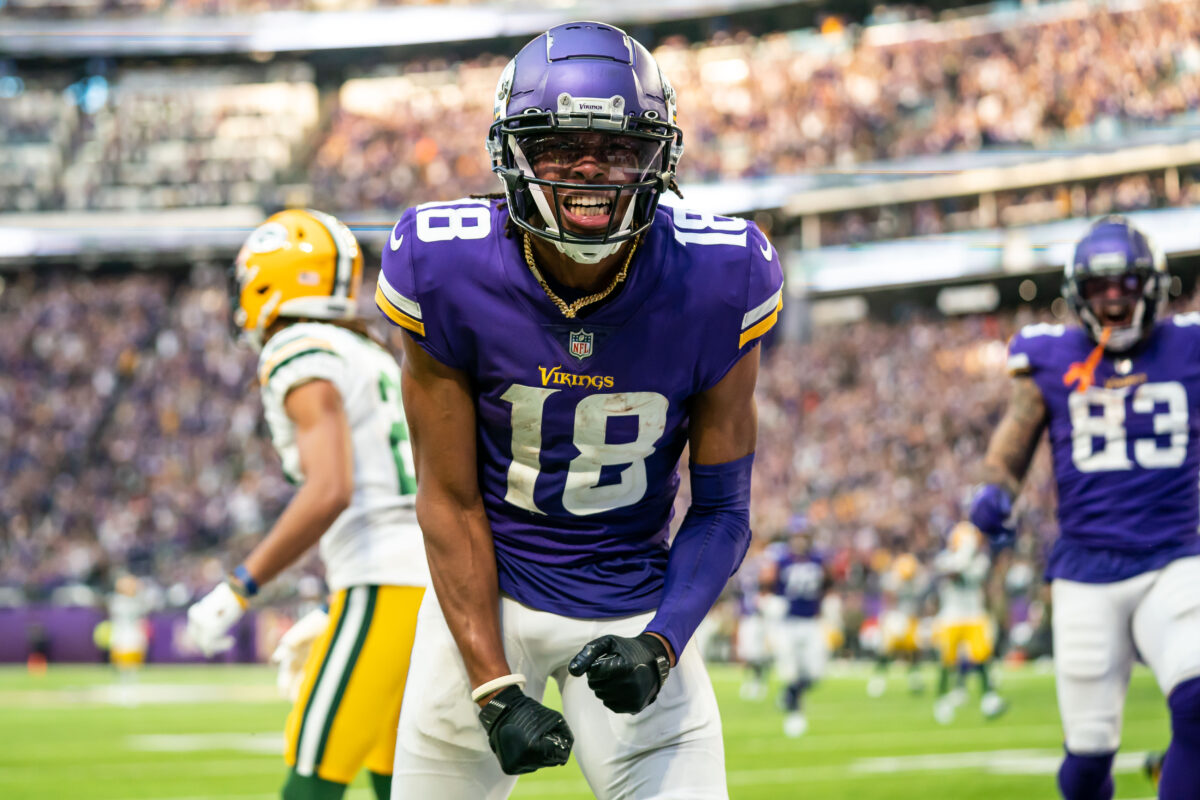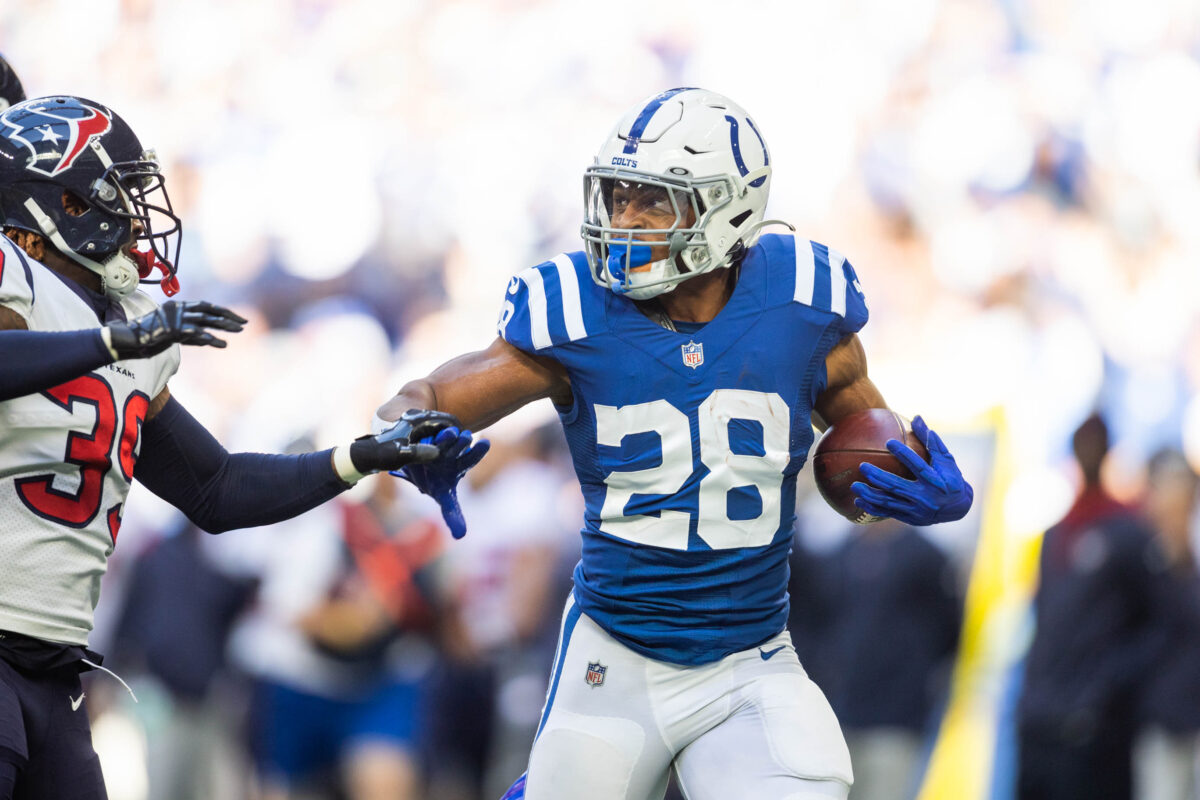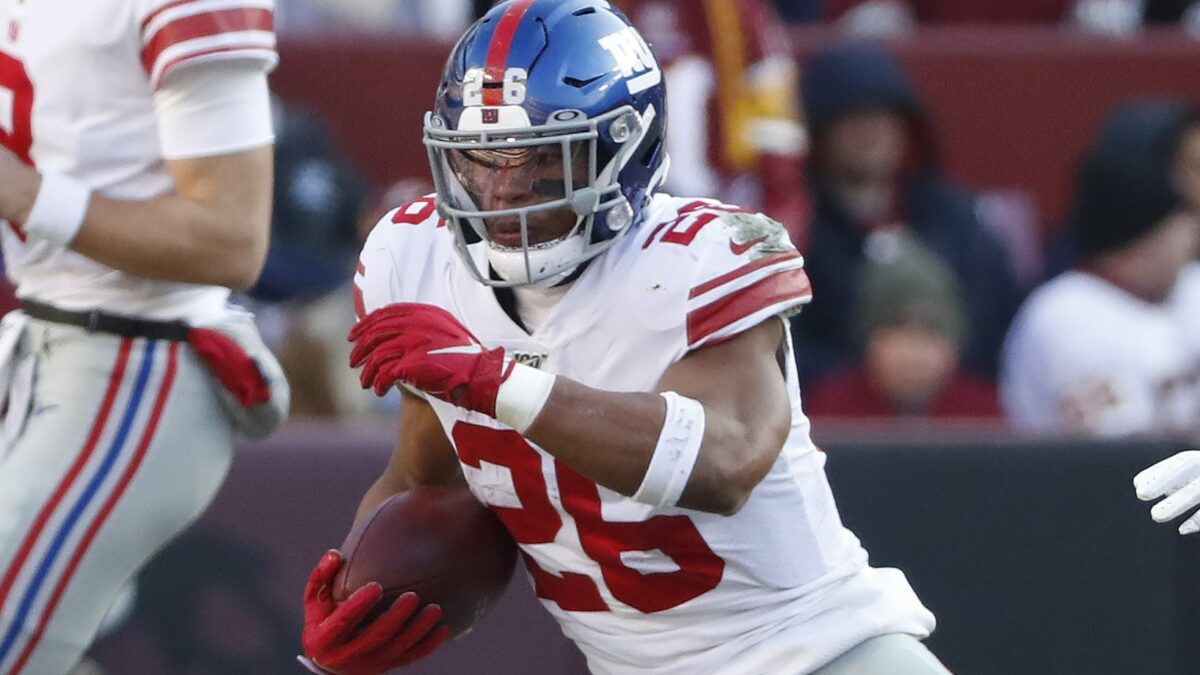Your first three picks define your fantasy football team. Each one is critical because the player pool is ever-shrinking, and you have to select a mixture of available players to produce an optimal team. And those initial rounds determine what you’ll do in the later rounds of the draft. Get them wrong, and you may not be able to recover.
To follow are sample three-round drafts for 12-team fantasy football leagues. They use either standard performance scoring, performance plus a point per reception, or “2QB/Super Flex” leagues where you can start two of any position. Those three formats cover virtually all leagues.
The names are less important than the positions because each draft slot has its own unique situation. Just as important are your future picks, and what you still need after three rounds. Rankings change daily so these may not exactly match site rankings. Pay the most attention to the positions and how they work together for an optimal start.
Performance scoring league

Average Points Top-10 scoring: QB 412, RB 228, WR 212, TE 127
Performance scoring without reception points means that top running backs are a premium, and quarterbacks are comparatively more valuable. Wide receivers and tight ends are devalued but still total four starters in most fantasy football leagues. Most teams take two running backs over their first three picks and it’s hard to argue against the logic because the supply is very low by Round 4.
The above three rounds are an optimal way to start the draft for all twelve draft slots. Let’s consider where each should be looking next after the three-pick start:
Team 1: RB Jonathan Taylor, QB Josh Allen, RB Devin Singletary
Top running back and quarterback are a big start. Cherry picking two wideouts over the next three rounds, and taking a third running back when the value seems best is in order.
Team 2: RB Derrick Henry, WR Stefon Diggs, RB Aaron Jones
The nice part of a top wideout is the consistent points. Best available with this start, but a third running back, a quarterback and another wideout make sense here.
Team 3: RB Austin Ekeler, RB Travis Etienne, WR Mike Evans
Same as Team 2. The next pick is too far to make concrete plans, but team is free to grab whatever. Strong start at running back means can wait on other positions. Best value will be wideout next, then quarterback.
Team 4: RB Christian McCaffrey, RB D’Andre Swift, WR CeeDee Lamb
This plan is pretty standard for the first half of the draft. And it usually works well in this format. This could be very good, but there is risk with McCaffrey and Swift from injury. Feel better to grab a running back and a quarterback next.
Team 5: RB Nick Chubb, WR Davante Adams, WR Tyreek Hill
Need to consider running back next, but will be looking at guys like Kareem Hunt, AJ Dillon, and Clyde Edwards-Helaire at best. Could go tight end and quarterback and then start scraping for upside running backs.
Team 6: RB Joe Mixon, WR Deebo Samuel, RB Antonio Gibson
In the middle of the draft, solid enough picks though nothing elite in any of them. Might consider a quarterback next just for a bigger bang for the buck and at least a slight advantage at the highest scoring position.
Team 7: RB Dalvin Cook, RB Leonard Fournette, WR Tee Higgins
The RB-RB start meant the No. 7 and No. 14 running backs, and there’s no advantage there but feels safe. Rather than collect more average (or worse) running backs, should consider quarterback and maybe even a tight end for the paper-thin advantage there.
Team 8: RB Najee Harris, RB Alvin Kamara, QB Patrick Mahomes
While this was much the same as Team 7, it looks better. Harris loses a lot without reception points but Kamara high-upside pick with, at least so far, risk. Scooping Mahomes up in the third means free to go where ever but needs one or two wide receivers pretty soon.
Team 9: WR Cooper Kupp, RB Saquon Barkley, RB J.K. Dobbins
This is riskier than most but Pick 9 is often the worst slot. Resisted yet another running back and gets advantage at wideout. Barkley is a scratch-off lottery ticket again this year and Dobbins fresh from his ACL tear is a risk. But at least has a core of starters. Next three picks should consider best available among any non-kicker/non-defense.
Team 10: RB Javonte Williams, WR Justin Jefferson, TE Mark Andrews
Drafting this deep, still went with the ninth running back taken. But arguably Top-2 at wideout and tight end offers some advantage. Has to look at running backs for at least the next two picks.
Team 11: WR Ja’Marr Chase, RB Ezekiel Elliott, RB Cam Akers
Chase is great in any format and two running backs just played it safe. Only two picks away from the fourth choice and Justin Herbert would be a nice add. Fifth and sixth picks should likely be a wideout and a running back.
Team 12: RB James Conner, TE Travis Kelce, WR Michael Pittman Jr.
Taking the tenth running back is no advantage, but waiting until the turn at the end of Round 3 would mean Damien Harris or David Montgomery as his best back. Getting Kelce is far less advantageous without reception points, but still makes sense here. Should still consider the 4.01 for running back.
Reception-point league

Average Points Top-10 scoring: QB 412, RB 278, WR 314, TE 197
This scoring style boosts the value of wide receivers and elite tight ends but devalues quarterbacks. Running backs are popular in any scoring scenario, but the added reception point means the position becomes deeper with third-down backs able to offer “start-able” fantasy value.
After the first ten or so wideouts are gone, the position will remain slightly better than comparable running backs but are also much deeper.
Team 1: RB Jonathan Taylor, WR Keenan Allen, TE Mark Andrews
The obligatory pick of Taylor was followed by the double scoop at the 2.12 and 3.01. Then went with tenth wideout for a legitimate WR1 and Andrews is more of a difference maker when the reception point is added. The next wrap- around at 4.12 and 5.01 pick from remaining committee backs and maybe take two since Top-3 quarterbacks are gone anyway.
Team 2: RB Austin Ekeler, RB Saquon Barkley, WR Michael Pittman Jr.
Safe enough start that works well depending on which Barkley shows up. But the core is accomplished and best available players are up next. Probably should consider a third running back over the next three picks.
Team 3: RB Christian McCaffrey, WR Tyreek Hill, RB L. Fournette
Bit of risk here for an early pick, but the upside of both McCaffrey and Hill are immense. Picked up the RB2 for a start that could be great if it all falls the right way. Has the luxury of taking the best available for the next two rounds and that probably will be his WR2 and RB3.
Team 4: RB Derrick Henry, RB James Conner, WR D.J. Moore
The safe start feels good but Moore as his WR1 is no advantage. Solid running backs mean two more wideouts are next and maybe a quarterback if a Top-3 still exists by the 6.09.
Team 5: WR Cooper Kupp, RB Alvin Kamara, RB Ezekiel Elliott
This could be deadly if Kamara doesn’t wear an all-orange uniform and Elliott rekindles 2019. But it could also have holes if it goes wrong. The risk of Kamara and Elliott means taking the RB3 sooner than later. But exciting start with upside.
Team 6: WR Justin Jefferson, WR CeeDee Lamb, RB D. Montgomery
By mid-draft, why not start out with two Top-8 wide receivers? Has a great advantage there and has to mine running backs to get lucky on the RB2, but good plan in the middle of a draft.
Team 7: RB Najee Harris, RB Javonte Williams, RB Travis Etienne
This is a big temptation assuming a flex position for Etienne to fill. And running back is the position that is fastest to drain. Now has to mine wideouts and the best will be Darnell Mooney/Mike Williams quality which isn’t terrible. The biggest risk here is that running backs are the most injured positions, and the first three picks have a higher chance of missing time.
Team 8: RB Joe Mixon, WR Mike Evans, RB Aaron Jones
Starts with the No. 6 running back and No. 7 wideout. This tough-to-succeed slot is building an average team. That works only when more than half the league goes to the playoffs (ands they don’t). Should look at quarterback and tight end next to gets at least some advantage in two positions.
Team 9: RB Dalvin Cook, RB Nick Chubb, WR Tee Higgins
Like Team 8, this is the safest-feeling route but begins with the No. 7 and No. 10 running back, followed by the No. 13 wideout who is a WR2 for his team. No fan of picking ninth, and this looks like another average team. Needs to find some sparks in other positions.
Team 10: WR Ja’Marr Chase, RB D’Andre Swift, RB Devin Singletary
WR1 is spectacular, and combining Swift and Singletary are a safe play. But has the option of A.J. Brown or Brandin Cooks at the 4.03 and possibly Mahomes or Herbert in the fifth round for a better bang in starters.
Team 11: WR Stefon Diggs, WR Deebo Samuel, TE Kyle Pitts
Picking at the end of the first round in this scoring format should be exciting and unconventional. Teams 8 and 9 went the safe route which felt natural at the time but Team 11 took a swing for the fence. Two Top-6 wideouts mean they can wait for four or even six rounds to start collecting WR3 candidates. Needs running backs, and three of them sooner than later since best available at the 4.02 is probably Cam Akers, Antonio Gibson or Breece Hall.
Team 12: TE Travis Kelce, WR Davante Adams, QB Josh Allen
This is how to handle picking last. There is no major advantage in taking running backs at the end of the first round, but owning the No. 1 tight end and quarterback is big in this scoring format. Taking the No. 5 wideout is rock solid for WR1. This does force need picks for running backs that should happen no later than the 5.12 and 6.01 wrap-around. That would yield at best often injured rushers or the RB2 from a committee backfield. But this can win if a sleeper running back can be found.
Super Flex / QB-heavy league

Average Points Top-10 scoring: QB 412, RB 278, WR 314, TE 197
This league seeds quarterbacks depending on how and why quarterbacks are so valuable. The most common is the option to start two quarterbacks. That pushes value in other positions deeper into the draft since quarterbacks take up far more of the early picks. Each 2QB or super-flex league can use different scoring and other aspects that impact player value, so consider the nuances of your league.
This assumes super-flex, where the option to start a second quarterback in a flex position exists and is used by most if not nearly all team owners. Some leagues can have eight quarterbacks in the first round and six in the second round. In others, maybe half as many. So pay attention and assume the worst when the quarterbacks start flying off the shelf.
It is also assumed that there are reception points. That is by far the most common in that type of league. It is also notable that a team can win without automatically starting two quarterbacks, even when allowed.
Team 1: QB Josh Allen, WR Ja’Marr Chase, QB Aaron Rodgers
Double-dipping on quarterbacks over the first three picks is very common – like taking two running backs in the other league formats above. The great part is that wideouts tend to last longer. So snapping up a running back or two makes sense because likely the best available is David Montgomery or Travis Etienne. Wideouts will last longer and they already have a Top-3 WR1.
Team 2: RB Jonathan Taylor, RB D’Andre Swift, QB Trey Lance
They went for strength in running backs, unable to pass Taylor or Swift. By Trey Lance at QB14, the pickings are already riskier if not unlikely to be an advantage. But can look at wideouts over the next three picks with some quality and decide if seeding the QB2 makes sense.
Team 3: QB Patrick Mahomes, RB Dalvin Cook, RB Nick Chubb
Safe play. Getting the Mahomes for QB1 feels great, and two of the Top-9 running backs are at worst solid. QB2 isn’t going to be an advantage even at the 4.10, so shop for wideouts with an eye out for the worst QB2 you can be okay owning.
Team 4: RB Austin Ekeler, QB Russell Wilson, RB Javonte Williams
Similar to Team 3, swapping the first two positions selected. And the same issue exists – needs wideouts and quarterbacks are slipping fast.
Team 5: QB Justin Herbert, QB Matthew Stafford, WR Stefon Diggs
Picking in the middle rounds hurt less in this format. They get a top quarterback and then doubles down with Stafford in Round 2. Still reached a Top-5 wideout in Round 3 but running back becomes a need pick – at least two in the next three rounds.
Team 6: RB Christian McCaffrey, QB Tom Brady, RB Alvin Kamara
This could be spectacular or a flop depending on McCaffrey’s health, Kamara’s legal limbo and if Brady can continue to perform decades after his peers disappeared. This plan is safe and has a ton of upside, but wideouts are on tap in two of next three picks.
Team 7: WR Cooper Kupp, WR Justin Jefferson, QB Derek Carr
Interesting start in this format – could not resist the top two wide receivers. Can wait on WR3 until after the middle of the draft. But mining quarterbacks and running backs are an immediate and pressing need.
Team 8: QB Joe Burrow, RB Joe Mixon, RB James Conner
Another safe play from the dreaded eight-spot. Wideouts and quarterbacks need to take up at least three of the next four picks.
Team 9: TE Travis Kelce, QB Kirk Cousins, WR Davante Adams
This is a little early for a risk taker but this worked out well in this format as this draft unfolded. Kelce is always an advantage but was still able to reach the No. 9 quarterback as QB1 and Adams lasted until the 3.09. That can happen in this format. If wideouts are taken more heavily, it only improves the running backs and quarterbacks at the 3.09. Regardless, running back is a need now but wideouts and tight ends are not.
Team 10: QB Dak Prescott, RB Najee Harris, RB Leonard Fournette
Starting with QB1 makes sense, and Top-5 RB1 is strong. By the 3.10, quarterbacks are into the bottom half of starters and went the safe route with the thirteenth running back as his RB2. Now has to consider wideouts and quarterback.
Team 11: QB Kyler Murray, QB Jalen Hurts, RB Saquon Barkley
This format favors the end of the first round more than the start. They can take two of the Top-8 quarterbacks for a major weekly advantage. The fourteenth running back isn’t much help as RB1 and all positions will be weaker, but the point differential with two starting Top-8 quarterbacks could compensate very well.
Team 12: RB Derrick Henry, QB Lamar Jackson, RB Ezekiel Elliott
Started RB-QB but then had to chose from the No. 15 running back, No. 16 quarterback or the No. 6 wideout. Picks again immediately and should go with that wideout. But should consider QB2 with the 5.12 even though the remaining options are not great.





















